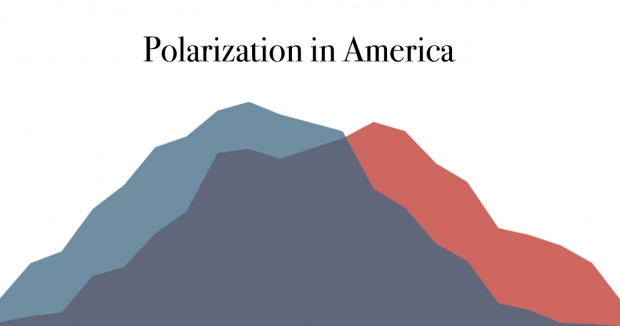Political Polarization in America, in Two Fascinating Charts

Polarization in America is something I've been able to get a clear sense of when reading the news or checking social media, but ever since I saw these two charts illustrating the problem, I haven't been able to get them out of my head.
The first, from The Economist (Lean Left media bias), shows the distribution of ideology of House candidates who won their primaries in 2018.
The second, from Pew Research Center (Center media bias) shows the distribution of Democrats and Republicans on a 10-item scale of political values. Here, too, we can see that ideological overlap between the parties is vanishing.
Democracy is built on compromise, and historically, a set of shared values tied Americans together and helped those on the Left and Right to come to mutual agreement — even with their differences. But as the overlap between the parties — and the core values they embody — draws ever farther apart, it becomes increasingly hard to imagine how Americans will be able to solve problems through mutual agreement.
Pew in particular points to some troubling data. In each party, the share of those with "a highly negative view" of the other party has more than doubled since 1994.
That data is from 2014. Since the election of Donald Trump and far-left representatives like Alexandria Ocasio-Cortez (D-NY), the divide has grown even larger. Pew data from 2017 also shows a widened division on key issues, including:
Government aid. More Democrats and Democratic-leaning independents say the government should do more to help the needy, even if it means going deeper into debt. 54% believed this 6 years ago; now 71% do. Between 2007 and 2011, the share of Republicans expressing this view fell from 45% to 25%.
Race. When Pew asked Americans if they believe racial discrimination is the main reason many blacks cannot get ahead, they found a difference of 50 points between Republican and Democratic views. That gap was 13 points in 1994, and 19 points in 2009.
Immigration. In 1994, 32% of Democrats said immigrants strengthen the nation; now a whopping 84% do. Republicans are divided: 42% have a positive view of immigrants, and 44% say they're a burden and take jobs, healthcare, and housing. Yet Republicans have inched closer to Democrats in their views: in 1994, 30% of Republicans had a positive view of immigrants, while 64% said they were a burden.
"But the bottom line is this," Pew notes. "Across 10 measures that Pew Research Center has tracked on the same surveys since 1994, the average partisan gap has increased from 15 percentage points to 36 points."
Deepening divisions in America don't just pose a threat to our political leaders' ability to come together for lawmaking — ideological divisions cut right at the heart of everyday citizens' interactions in our homes, neighborhoods, workplaces and communities.
When we disagree wildly on issues that we believe will make or break our country's ability to thrive, it can make any conversation that goes deeper than the weather to become strained and uncomfortable. It might even make us want to avoid our neighbors entirely, to insulate ourselves in an echo chamber of comfort, where the only folks we interact with already agree with us. It might make us feel safe, but it certainly doesn't solve anything.
At AllSides, we've written before about how echo chambers aren't just physical, but virtual: the internet literally trains our brains to polarize and despise. And we talk at length about civility, and how we need to make our disagreements tolerable so that we can share a life together.
Here are few ways to address the polarization problem:
Become aware of your own biases. The first step to addressing the polarization problem is in your own head. Learn how the internet reinforces your beliefs, and then think about how this can blind you to different perspectives that may actually be valid, not worthy of hatred. Take AllSides' bias quiz to figure out where you stand on key issues. Then, own your bias — don't hide it.
Consume a balanced news diet. AllSides provides balanced news from multiple angles — side-by-side so you can decide the truth for yourself. We also provide over 600 media bias ratings to help you become aware of the slant of your favorite news outlets.
Practice civil discourse. Listen to others, be heard, and learn about unique perspectives by engaging in responsible free speech.
Be willing to learn from other perspectives. I've had multiple people tell me they watch Fox News (Lean Right media bias) "just because it's fun to yell at the TV." Or folks who "hate read" Vox. That means they're approaching the news with the biased belief that there's nothing for them to learn. Instead of having an openness to a different perspective, they consume just to mock. Take in different views in earnest, not in jest. Our country will thank you.
Julie Mastrine is the Director of Marketing at AllSides. She has a Lean Right bias.

July 25th, 2024


July 25th, 2024

July 24th, 2024